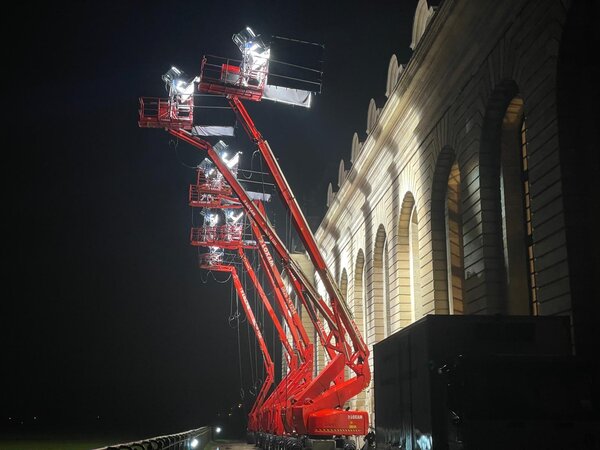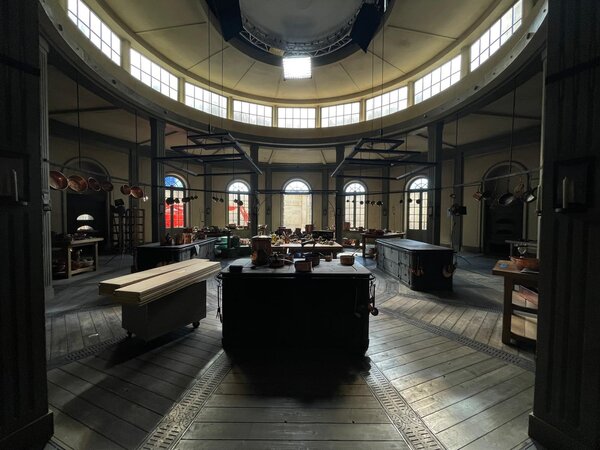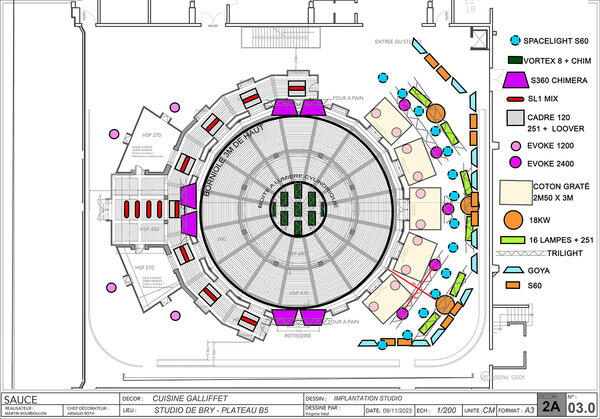AFC Interviews at Lille’s "Series Mania" Festival
Matias Boucard, AFC, reflects on the visual choices made for the Apple TV+ series “Carême”, directed by Martin Bourboulon
"Filming a period piece in a contemporary way", by François Reumont“Carême” tells the story of Antonin Carême (Benjamin Voisin), the first chef in the world to achieve fame and become, after modest beginnings in Paris, a master of the culinary arts in the early 19th century. Driven by a single goal, to become the most famous chef in the world, his talent and ambitions draw the attention of powerful and renowned politicians who will recruit him as a spy for France. Determined to escape his situation and fulfill his dream, Carême has the choice between revenge or having it all - women, money, glory - but at what price : love ? His life ? His soul ?
“Carême” is a period series, but one with a fairly modern look…
Matias Boucard : Right from pre-production, Martin Bourboulon and I had a lot of discussions about the visual style of the series. We quickly agreed that we were going to make a period film, but not necessarily a historical one. I mean, from a purely realistic point of view. In short, we wanted to treat the period in a contemporary way, so that the broadest possible audience around the world could relate to it. In a way, it was a real gamble. How do you navigate through the era’s conventions while creating a strong visual signature that everyone can immediately recognize as they flip through the channels looking for something to watch ? I think that’s become very important for series nowadays.
As it was a mixture of a period drama, espionage and, above all, cooking, my initial idea was to stay as true as possible to the color of the food. That meant coming up with a visual environment, and a fairly strong look, while avoiding too much emphasis on the rich golds and warm colors of candlelight. For example, I avoided at all costs an image that was too brown and chestnut-colored, and I stayed as neutral as possible, playing with a certain contemporary aspect of light in this period film context.

Any references ?
MB : I thought a lot about Stephen Frears’ Dangerous Liaisons, lit by Philippe Rousselot, AFC, ASC. I particularly remember the almost white candles that left a lasting impression on me in this film set in the 18th century. And then I also watched Sofia Coppola’s Marie Antoinette (cinematography by Lance Acord, ASC), particularly for its deliberately provocative modernity, embracing anachronisms in both the image and the music...
For “Carême”, we went for a rather bright image, in “High Key” mode, working a lot with sunlight coming into the sets, deciding, for example, to bring the kitchens from the basement up to the ground floor, to the level of the main rooms. A deliberate anachronism that immediately freed us from the constraints of very warm candlelight or wood-fired ovens that were the norm in these places at the time. The other decision was to shoot in very large format, with the Arri Alexa 65, to give the backgrounds a much stronger dimension. To make better use of all these sets by shooting wide shots with much longer focal lengths than in conventional 35mm mode or even Full Frame. This way, we really make the most of the volume of each location, even in relatively close-up shots of the actors. It is, for example, very different to find yourself shooting the widest shots with a 35mm, when you usually have to use an 18 or 20mm... With the Alexa 65, there are almost no boundaries between wide shots and close-ups. Everything is done with just a few lenses, without distortion, with the impression that you are shooting in wide format or composing a painting.

How did you shoot ?
MB : The series was shot with two cameras, mainly due to time constraints. But once again, the Alexa 65’s ability to make the most of the sets even in a medium shot makes this configuration easier. As for the lenses, I outfitted the two camera bodies with Arri Prime DNAs, a modern series built from vintage lenses that offer both a very smooth look and excellent definition while covering the entire sensor (54.12 x 25.58mm).
It was very important for me to have lenses that were soft enough to avoid using smoke, and once again to use the very sharp beam-like daylight shots characteristic of certain Napoleonic films. We had 15 days per episode to shoot “Carême”. That’s pretty cushy for a series in France, but given the number of sets and the complexity of the period film, it was actually tight... For example, there were high expectations for the artistic direction and visual value of each location. And a desire for generosity in the image in the scenes, whatever they were. In a way, it didn’t really look like a series shoot, but more like an eight-episode feature shoot. In any case, the Apple TV+ team was very pleasant, with genuine collaboration in terms of the sets, the costumes, and good organization considering all the castles in the Paris region that we trawled through.

Was everything shot on location ?
MB : No, the recurring set of the “Carême” kitchen (at Talleyrand’s home) was recreated in Bry-sur-Marne in the studio. It involved a lot of work and planning with Arnaud Roth, the production designer, and Laurent Héritier, who was my gaffer on this project. We spent almost a month on this set, preparing almost all the atmospheres in advance in pre-light, so that we could very quickly switch from one to the other according to the shooting schedule. Thanks to this joint effort with Martin and Arnaud, we were able to place the windows in the ideal positions, as well as the skylights, to achieve this very bright set, often flooded with sunlight. This is in stark contrast to a castle kitchen lit only by candlelight.


However, the other kitchen sets were actually filmed in real life, either in authentic castle kitchens or sometimes in other locations, such as the stables of Chantilly, which we had redecorated. When I alluded to the modernity of the image and my approach to lighting on this film, it is of course also very much the contemporary look of the sets that I relied on. And I think that sometimes, without really realizing it objectively, you are almost in a contemporary kitchen, in the 1950s for example... A far cry from the early 19th century !
What lighting did you use ?
MB : I had opted for tungsten lighting on the prior film I made with Martin Bourboulon (Eiffel), but on “Carême” I decided to switch almost exclusively to LEDs, with the exception of a few very powerful sources (18kW HMI, Dino Light), which do not yet have an LED equivalent. The reason for this choice is mainly the flexibility, the speed of the settings, and the simplicity of installation. You know, when you arrive at a castle and several teams have already been there before you on previous films, often big productions, the owners are often a little tense because film shoots always leave their mark...

So, working with modern, battery-operated spotlights that use less power and are more lightweight is obviously a huge advantage. Real candles are now completely banned too... And to give you an idea, for the big party scene in episode 2, we completely did away with the latter, for example. By creating small cubes of light with the set design team, quite modern and entirely controlled by console, which give points of very white light, almost anachronistic given the context. This is really the kind of game that Martin and I allowed ourselves to play on the series, and which, I think, ultimately creates this visual identity between a period drama and the contemporary.

What have you taken away from this experience ?
MB : With this general choice of fairly bright interiors, I must admit that my eye gradually got used to shooting in these conditions, which are not all that frequent. Working on contrast more through colors than light, in collaboration with the set design and costume departments. And it was obviously a different way of composing and dressing the image. It was very different from a candlelit atmosphere with the decor disappearing into the darkness. You could really see all the details of the place, and you start to play with symmetries, compositions of frames that no longer rely on, for example, the depth of the light. And then six months of my life finding myself in castles and filming things around the kitchen... Honestly, it was a very pleasant memory.
- Laurent Héritier, gaffer on “Carême”
What were the main challenges for you ?
Laurent Héritier : When Matias presented the project to me, he immediately mentioned shooting with an Alexa 65, with its distinctive relationship between foreground and background, and the possibility of shooting quite wide shots with absolutely no distortion. The sets were given enormous importance, a very open field even when you are close to the actors. This was a very important factor for the lighting, given that the style of the series would tend to be quite bright, and all this at a fairly fast pace given the number of sets involved. On top of that, Martin Bourboulon really wanted to give a very modern feel to this series, both in terms of the sets and the costumes, by moving away from the use of candlelight or anything else that would be characteristic of the Napoleonic era. That is why, even though there are sometimes candles shown on screen, we stuck with lighting at much higher color temperatures, between 2,700 and 2,400K on the sources used.
There is also a lot of sunlight in this series, with hardly any gloomy ambiences, and very sharp light coming in, brilliance.

You have brought me the lighting plan for the main set, explain it to me.
LH : The large kitchen set was built in the Bry studio by Arnaud Roth’s team, with an architecture reminiscent of the large lobby of the Bourse du Travail (now the Pinault Foundation for Contemporary Art). A circular set on two levels. Upstairs, a corridor runs along the perimeter of the space, dotted with windows all along. To begin with, we determined the four cardinal points in relation to this set, in order to imagine the path of the sun throughout the day. Based on these elements, and in collaboration with the set designers, we gradually developed the entire lighting infrastructure so that we could very quickly switch from one atmosphere to another according to the needs of the shooting schedule. My team and I were able to benefit from two weeks of pre-lighting on this set, during which Matias lent me one of his personal cameras (an Arri Alexa LF) with which I was able to check the programming of the different atmospheres step by step. By recording a few images at the end of each session and applying the LUT he had given me, I was able to send him a dozen different mood suggestions, from sunrise to sunset, with many possible variations depending on the script. I really appreciated the great deal of trust he placed in me, and which continued throughout the shoot, from location to location.
Any details about the lighting equipment used ?
LH : Everything was controlled by a Granma 3 lighting console, and a console operator was responsible for programming it, allowing us to switch very quickly from one atmosphere to another on set. It was also one of the first shoots where we were able to use Nanlite’s Evoke 2400 LED projectors, which have a power output roughly equivalent to a 4kW HMI Cinepar, but with the ability to vary the color temperature from 2,700 to 6,500K. This source proved very useful in the studio, but also on location. It generates little heat and consumes much less power than an HMI. I must also commend the exceptional work of Sébastien Grasso, the key grip, and Clément Cantier, his head rigger, who took incredible care of all the locations we visited, leaving them without a scratch and with extreme attention to detail in the installations.
(Interview by François Reumont and translated from French by A. Baron-Raiffe, for the AFC)
 En
En Fr
Fr





